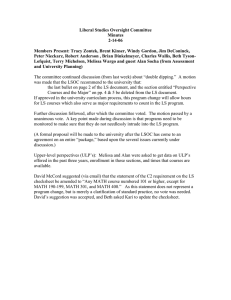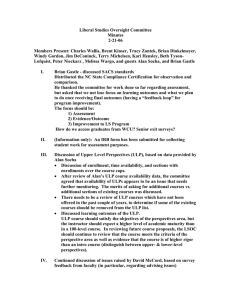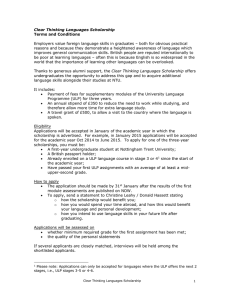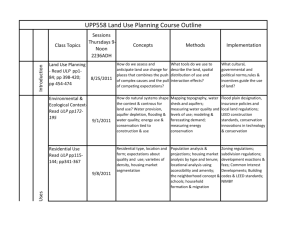Strategic Integration of Ultra
advertisement
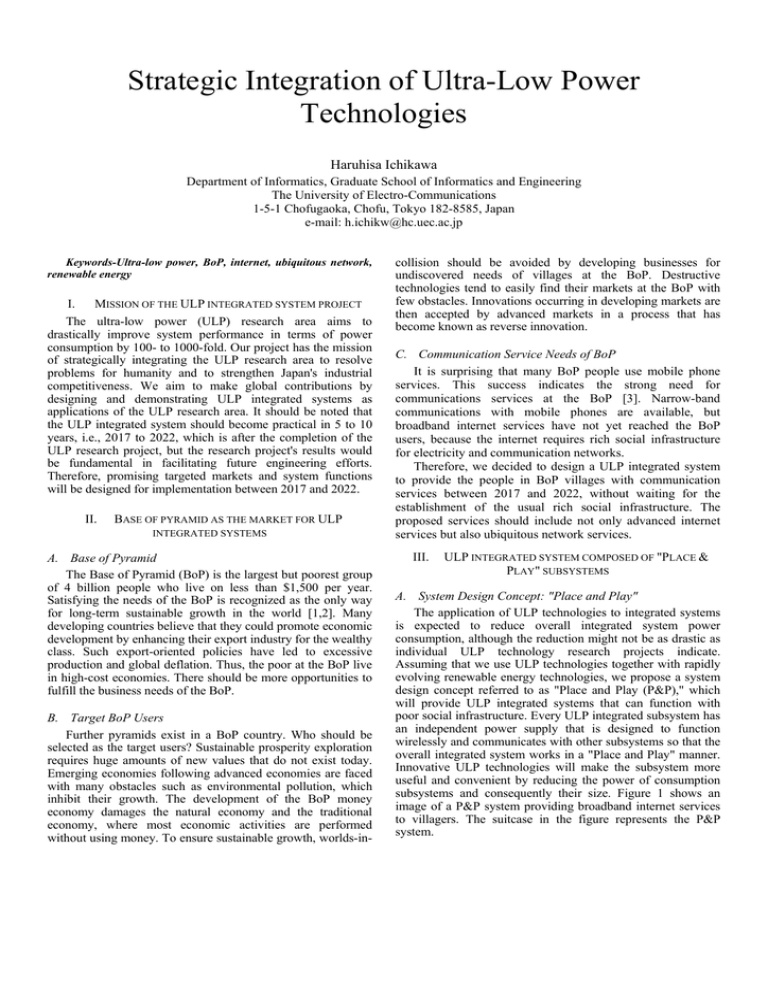
Strategic Integration of Ultra-Low Power Technologies Haruhisa Ichikawa Department of Informatics, Graduate School of Informatics and Engineering The University of Electro-Communications 1-5-1 Chofugaoka, Chofu, Tokyo 182-8585, Japan e-mail: h.ichikw@hc.uec.ac.jp Keywords-Ultra-low power, BoP, internet, ubiquitous network, renewable energy I. MISSION OF THE ULP INTEGRATED SYSTEM PROJECT The ultra-low power (ULP) research area aims to drastically improve system performance in terms of power consumption by 100- to 1000-fold. Our project has the mission of strategically integrating the ULP research area to resolve problems for humanity and to strengthen Japan's industrial competitiveness. We aim to make global contributions by designing and demonstrating ULP integrated systems as applications of the ULP research area. It should be noted that the ULP integrated system should become practical in 5 to 10 years, i.e., 2017 to 2022, which is after the completion of the ULP research project, but the research project's results would be fundamental in facilitating future engineering efforts. Therefore, promising targeted markets and system functions will be designed for implementation between 2017 and 2022. II. BASE OF PYRAMID AS THE MARKET FOR ULP INTEGRATED SYSTEMS A. Base of Pyramid The Base of Pyramid (BoP) is the largest but poorest group of 4 billion people who live on less than $1,500 per year. Satisfying the needs of the BoP is recognized as the only way for long-term sustainable growth in the world [1,2]. Many developing countries believe that they could promote economic development by enhancing their export industry for the wealthy class. Such export-oriented policies have led to excessive production and global deflation. Thus, the poor at the BoP live in high-cost economies. There should be more opportunities to fulfill the business needs of the BoP. B. Target BoP Users Further pyramids exist in a BoP country. Who should be selected as the target users? Sustainable prosperity exploration requires huge amounts of new values that do not exist today. Emerging economies following advanced economies are faced with many obstacles such as environmental pollution, which inhibit their growth. The development of the BoP money economy damages the natural economy and the traditional economy, where most economic activities are performed without using money. To ensure sustainable growth, worlds-in- collision should be avoided by developing businesses for undiscovered needs of villages at the BoP. Destructive technologies tend to easily find their markets at the BoP with few obstacles. Innovations occurring in developing markets are then accepted by advanced markets in a process that has become known as reverse innovation. C. Communication Service Needs of BoP It is surprising that many BoP people use mobile phone services. This success indicates the strong need for communications services at the BoP [3]. Narrow-band communications with mobile phones are available, but broadband internet services have not yet reached the BoP users, because the internet requires rich social infrastructure for electricity and communication networks. Therefore, we decided to design a ULP integrated system to provide the people in BoP villages with communication services between 2017 and 2022, without waiting for the establishment of the usual rich social infrastructure. The proposed services should include not only advanced internet services but also ubiquitous network services. III. ULP INTEGRATED SYSTEM COMPOSED OF "PLACE & PLAY" SUBSYSTEMS A. System Design Concept: "Place and Play" The application of ULP technologies to integrated systems is expected to reduce overall integrated system power consumption, although the reduction might not be as drastic as individual ULP technology research projects indicate. Assuming that we use ULP technologies together with rapidly evolving renewable energy technologies, we propose a system design concept referred to as "Place and Play (P&P)," which will provide ULP integrated systems that can function with poor social infrastructure. Every ULP integrated subsystem has an independent power supply that is designed to function wirelessly and communicates with other subsystems so that the overall integrated system works in a "Place and Play" manner. Innovative ULP technologies will make the subsystem more useful and convenient by reducing the power of consumption subsystems and consequently their size. Figure 1 shows an image of a P&P system providing broadband internet services to villagers. The suitcase in the figure represents the P&P system. IV. METHOD FOR EVALUATING ULP TECHNOLOGY IMPACT The aim of constructing the ULP integrated system is to show how integration of ULP technologies will satisfy BoP needs between 2017 and 2022, by demonstrating the system functions. We will quantitatively evaluate how the idealized P&P features might be realized. This method is illustrated in Fig. 3. It should be noted that the system can only be constructed with currently available products, so this system will be implemented without ULP technologies to demonstrate the need for ULP technologies. An example of the rural villages in India (Sharing internet terminal in a village) An image of P&P System providing broadband internet services to villagers Electric Power Power by independent power supply ULP Integrated Subsystems Power Consumption Fig. 1 An Example of Rural Villagers in India Sharing an Internet Terminal SystemBefore B. ULP Technologies Applied to ULP Integrated System Figure 2 introduces the P&P subsystem categories of the ULP integrated system and the concrete subsystem candidate where ULP technologies could be applied. ULP Integrated Subsystems constructed with current devices show: ‐ their functions ‐ the needs of ULP R&D results (needs to reduce the power consumption, physical size, etc.) ULP R&D Results Server System SystemAfter Mock‐up Power Consumption Client System Power by independent power supply Year ULP HPC center (Matsuoka) Today ULP cloud (Maeda) 10 years after the ULP Research Area ULP HPC computer (Takagi) P&P back yard system Data centre Power supply Low power inter‐terminal communication equipment (Kuroda) P&P surveillance camera (Goto) P&P backbone connected network Fig. 3 Method for Evaluating Strategic Integration of ULP Technologies Server ULP optical node (Sato) Field of view expanding‐ type camera (Takada) ULP core router (Koike) P&PTV conference sys (Takada) P&P core system P&P display sys (Kobayashi) P&P ubiquitous terminal RFID and sensor Image sensor (Goto) P&P access network system ULP Linux server (Nakamura) High‐performance sensor (Kuroda) Ubiquitous wireless server (Ichikawa) P&P wireless network (Nishikawa) Environmental power‐ supply type wireless tag (Ichikawa) High‐speed inter‐terminal communication equipment (Kuroda) V. Communication system (Ichikawa) ULP system cube (Kuroda) P&P client system Items management system (Ichikawa) Router Virtual wireless space network (Ichikawa) Internet cache system (Ichikawa) Suitcase-type P&P core system 3 The ULP integrated system under construction is displayed in our exhibition booth during ISLPED 2011, where we demonstrate how the system functions will satisfy the needs of BoP villagers. This demonstration assumes the villager needs that we identified during our visit to Bangladesh with the support of the Global Communications Center [5,6,7] and Grameen Communications [8]. Fig. 2 ULP Integrated System Applied with ULP Technologies C. Software System to Implement the ULP Integrated System Functions We have proposed an ULP integrated system to provide advanced internet services and ubiquitous services, as introduced in Section II. The suitcase in Fig. 1 simulates the P&P core system in Fig. 2, which is connected to the internet backbone by a narrowband network such as 3G (backyard system in Fig. 2). We are constructing an internet cache system to transport and mount the storage devices. Ideally, all the web content required by villagers will be on the P&P core system. Web content will be stored in devices at certain places where broadband internet access is available. A ubiquitous wireless network system is also being constructed, which we propose will support networking of ULP wireless tags and sensors, using energy harvesting technologies [4]. DEMONSTRATION SYSTEM REFERENCES [1] [2] [3] [4] [5] [6] [7] [8] C.K. Prahard and S.L. Hart, "The Fortune at the Bottom of the Pyramid," Strategy + Business, 00.54-67, 26, 2002. S.L. Stuart, "Capitalism at The Crossroads - Alligning Business, Earth and Humanity," Pearson Education, 2007. N.P. Sullivan, "You can Hear Me Now - How Microloans and CellPhones are Connecting the World's Poor to the Global Economy," John Wiley & Sons, 2007. H. Ichikawa, M. Shimizu and K. Akabane, "Ubiquitous Networks with Radio Space Extension over Broadband Networks," Trans. IEICE, Vol.E90-B, No.12, pp.3445-3451, 2007. http://gcl.kyushu-u.ac.jp/ http://igpf.gramweb.net/index.php A. Ahmed and T. Ohsugi , "Information and Communications Technologies to Innovate the Base of Pyramid," Shukosha, 2009. http://www.grameencommunications.com/

